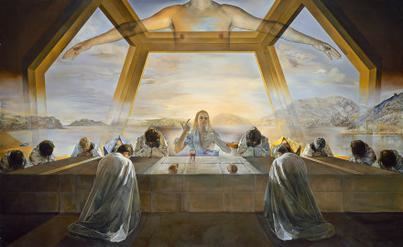Year 1955 Dimensions 2.67 m x 1.67 m Period Surrealism | Created 1955 | |
 | ||
Artists Salvador Dali, Mariano Salvador Maella Similar Salvador Dali artwork, Surrealist artwork, Oil paintings | ||
Salvador dali the sacrament of the last supper 3d
The Sacrament of the Last Supper is a painting by Salvador Dalí. Completed in 1955, after nine months of work, it remains one of his most popular compositions. Since its arrival at the National Gallery of Art in Washington, D.C. in 1955, it replaced Renoir's A Girl with a Watering Can as the most popular piece in the museum.
Contents
- Salvador dali the sacrament of the last supper 3d
- Audio guide video the sacrament of the last supper dali
- Background
- Description
- Symbolism and Interpretations
- References
Audio guide video the sacrament of the last supper dali
Background
The Sacrament of the Last Supper was completed during Dalí's post-World War II era, which is characterized by his increased interest in science, optical illusion and religion. During this time he became a devout Catholic and simultaneously was astonished by the "atomic age". Dalí himself labeled this era in his work "Nuclear Mysticism". He sought out to combine traditional Christian iconography with images of disintegration. This is especially apparent in his piece The Madonna of Port Lligat, which was completed six years earlier.
The painting wasn't commissioned. After purchasing the Crucifixion and then giving it to the Metropolitan, collector and banker Chester Dale told Dalí he "had to do one more religious picture". In a paragraph in the National Gallery's curatorial file but is missing from all published accounts, Dalí wrote of this picture:
The first Holy Communion on Earth is conceived as a sacred rite of the greatest happiness for humanity. This rite is expressed with plastic means and not with literary ones. My ambition was to incorporate to Zurbarán's mystical realism the experimental creativeness of modern painting in my desire to make it classic
Description
The Sacrament of the Last Supper depicts thirteen figures gathered around a table. Assuming this painting is in line with traditional symbolism the figures are Christ and his 12 Apostles. Christ is the center figure in the painting placed directly on the horizon line. Directly behind him on the intersection point of perspective rests the source of sunlight making the Christ figure the focus of the painting. He points upward directing the viewer’s attention to a dominating transparent torso with arms stretched outward spanning the width of the picture plane. The scene’s setting is within a transparent dodecahedron, or twelve-sided space as perceived in the pentagon shaped windowpanes behind the table. In the background is a familiar landscape of Catalonia, which Dalí has included in his paintings numerous times, one example being his famous painting The Persistence of Memory.
Symbolism and Interpretations
The combination of a classic Christian theme with the jarring techniques of Surrealism captures the eye, as Dalí was able to do repeatedly with such works as The Temptation of St. Anthony, Christ of Saint John of the Cross, Crucifixion (Corpus Hypercubus), Nuclear Cross and The Ecumenical Council, among others. The composition was laid out using the Golden Ratio. Even the large dodecahedron in the background is very closely related to the Golden Ratio.
There have been many interpretations of this painting, but some critics have dismissed the piece, with the Protestant theologian Paul Tillich even calling it “junk.” Michael Anthony Novak, a Catholic theologian, presented a paper on the subject of this piece in 2005. He proposes that Dalí’s intention was not to simply paint the event of the last supper. He later stated:
Dalí's true intention, which he has masterfully accomplished on this canvas, is to remind us of what is occurring in every celebration of this mystery of bread and wine: that the worship here on Earth makes present the realities of worship in Heaven.
Other critics, like Novak, say, by looking at the title, the focus is not placed on one evening two thousand years ago. The lack of individualization of the apostles, their lack of focus on Christ and the almost dematerialized Christ reaches beyond the fact of the event. Some say because Christ points to himself and the floating torso above him it could possible be that he is referring to himself as his spirit has already ascended to heaven.
